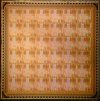EEC 116 Glossary of Technical Terms
Terms and acronyms commonly used in EEC 116.
- ASIC (Application-Specific Integrated Circuit)
- A chip designed for a specific application. (as opposed to a chip
such as a generic memory chip or a general-purpose processor, for example)
- chiplet
- A single chip typically smaller than it would otherwise be due to the
fact it is designed to be combined with other chiplets inside a single
package.
- CMP (Chemical Mechanical Planarization or
Chemical Mechanical Polishing)
- A step in the fabrication process which results in an
extremely flat chip surface.
- device
- Normally refers to a single transistor (NMOS or PMOS). Depending on
the context, it may also refer to a single die.
- die or chip
- A single semiconductor integrated-circuit which is typically
placed inside a package.

- diffusion
- Normally refers to ndiffusion and/or
pdiffusion.
- DRC (Design Rule Check)
- Computer program (or part of a CAD program) used to check
design rules of layout.
- DSM (Deep Sub-Micron)
- Semiconductor fabrication technologies with minimum feature
sizes well below 1 micrometer (micron). Very roughly includes
technologies below 0.25 um.
- electromigration
- Damaging effect on metal wires under high current conditions,
which causes the movement of metal atoms and the possible eventual
open-circuit or short-circuit failure of the wire. The effect is
accelerated by uni-directional current and high temperature.
- fabrication technology (or technology)
- The name given to the set of processes utilized to fabricate an
integrated circuit. This name either consists of or includes the
minimum feature size achievable by the manufacturing process.
(e.g., "14nm technology" or "22nm CMOS")
- Fin-FET
- A type of MOSFET field-effect transistor (FET) distinguished by
a transistor channel that is on top of the substrate rather than
embedded within it, and the channel is surrounded by the gate on
three sides (typically).
- flip-flop
- A memory element. Normally used to describe only edge-triggered
memory elements. (Rabaey uses the term to refer to any bistable
component formed by cross-coupled gates.)
- irsim
- CAD tool for switch-level circuit simulation; originally
developed at Stanford.
- latch
- A memory element. Normally used to describe transparent
(i.e., when the clock is at its active level) memory
elements.
- magic
- CAD tool for full-custom chip layout; originally developed at
UC Berkeley.
- metal
- Term used to refer to any of the metallic "upper" interconnect
layers in an integrated circuit. Layers are typically made of
aluminum or more recently, copper. Advancing generations
typically contain more metal layers. For example,
0.25µm / typically has 5 metal layers,
0.18µm / 6 layers,
0.13µm / 8 layers,
IBM 90nm / 12 layers,
Intel 14nm / 13 layers.
- NMOS (N-type MOS)
- N-channel MOS transistor.
- ndiffusion (or ndiff)
- The heavily-doped n-type part of an NMOS transistor making
up the transistor's source and drain.
- NoC (Network on Chip)
- A communication network contained on a chip.
- oxide
- A compound of oxygen with another element. Normally refers
to silicon dioxide in the context of integrated
circuits.
- package
- A physical chip carrier designed to protect and provide electrical
connections to the chip inside it.
- PMOS (P-type MOS)
- P-channel MOS transistor.
- pdiffusion (or pdiff)
- The heavily-doped p-type part of an PMOS transistor making
up the transistor's source and drain.
- poly (polysilicon or polycrystalline silicon)
- Material made of polycrystalline silison (neither perfectly
crystalline nor amorphous) commonly used as the gate for modern
MOS transistors.
- register
- A memory element. Normally used to refer to either a latch or
flip-flop. (Rabaey uses the term to refer to only edge-triggered
memory elements.)
- sheet resistance
- Resistance of a material with an assumed resistivity (ρ)
and thickness. Uses units of Ω/square.
- Silicon dioxide or SiO2
- An electrically-insulating material made of silicon and oxygen
commonly used to insulate conductors and semiconductors in
integrated circuits.
- SoC (System on a Chip)
- A chip containing complex subsystems (e.g., wireless interfaces,
DRAM controllers, video processors, AI engines, etc.) commonly
inter-connected by one or more networks on chip (NoC).
- substrate
- The silicon wafer onto which CMOS integrated circuits are
built.
EEC 116
| B. Baas
| ECE Dept.
| UC Davis
2005/04/02 Written
2006/04/11 Updated for Spring 2006
2013/10/21 Added CMP
2016/09/21 Formatting changes
2018/10/01 Added a few entries
2018/10/04 Added a few entries
2023/08/22 Added a few entries: FinFET, chiplet

